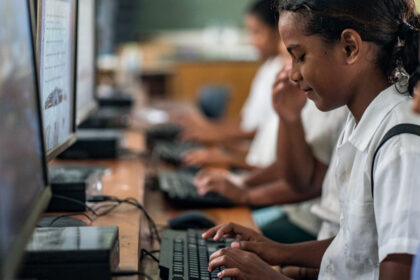
Digital technology can improve the efficiency and quality of education at all levels. Part of ADB’s strategy to support its education policy principles is promoting “experimentation with, and dissemination of, innovative strategies and technologies in education.” This involves developing appropriate e-applications to help DMCs leapfrog conventional means of learning and teaching. For example, Uzbekistan’s Digital Technology in Basic Education Project, supported by a $30-million ADB loan, is bringing education to remote rural areas and benefiting 540,000 students.
Without the skills to fully realize the benefits of ICT the digital divide becomes an even bigger information literacy divide. A key aspect of a knowledge economy is an information-literate and ICT-capable labor force. ICT provides increasingly effective ways to reach out to rural dwellers in remote areas and disadvantaged groups that do not have access to quality educational opportunities, thus providing them with a link to global networks and the global economy.
ADB’s ICT initiatives in education improved skills training in poor rural areas by making up-to-date learning resources available online for distance learning for students, teacher training, and professional development. ICT also improves education administration by connecting district-level offices to the central education ministry.
Featured ICT-related Projects and Activities in the Education Sector
| Title | Description |
|---|---|
| Secondary Education Sector Investment Program – Tranche 1 | This loan aims to develop a more efficient, equitable, and higher-quality secondary education system. One of its outputs is “enhanced use of information and communication technology for pedagogy.” The program will review on-going ICT projects to inform development of a school information hub plan for installation of approximately 10 computers with internet access and related equipment, maintenance, security, and facilities in 5,000 schools. |
| Information and Communication Technology for Better Education Services | The TA will enhance capacity of the education sector in ICT application at subnational levels. It will carry out the following: (i) development and implementation of a gender-inclusive ICT plan linking MEHRD, provincial education authorities and schools; (ii) identification of ICT hardware options, development of suitable applications, and piloting their use in rural or remote areas, including capacity building; (iii) comprehensive assessment study conducted on how enhanced access to ICT can add value to the DFL; (iv) convene ICT4E workshop and forum to raise awareness, identify potential and constraints, and share findings and lessons learned from the TA outputs. |
| Higher Education in the Pacific Investment Program – Tranche 1 | This loan aims to achieve expanded and equitable access to quality higher education in USP member countries, especially for women and students from remote outer islands. One of its outputs is the expansion of the USP Kiribati campus to accommodate the rapidly increasing number of students by constructing additional classrooms, an ICT studio, a student cafeteria, and administration facilities. New ICT equipment will be provided to connect to other regional campuses, and deliver faster and more reliable ICT-based learning courses, especially DFL courses. |


